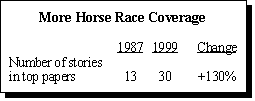Other Political News

Americans in general have a positive view of George W. Bush and Elizabeth Dole — nearly three times as many describe these Republican candidates in positive terms as describe them in negative terms. For Bush, the most common description is “good,” with “okay,” “unknown,” “leader,” and “honest” also in the top five. Overall, 61% of Americans have a favorable opinion of Bush.
Dole is also described in mostly positive terms by the public, much as she was in 1996, when her husband was the Republican presidential candidate. “Intelligent,” “strong” and “good” continue to be the most commonly used terms to describe Elizabeth Dole, with “smart” and “alright” rounding out the top five.
Dole’s favorability ratings, however, have slipped somewhat over the past several months as her visibility has increased. In January, 66% had a favorable opinion of Dole, today her rating stands at 58% favorable.
In a match-up with Gore, Dole leads 52%- 42%. Dole runs particularly well among white women, women under 30 and rural voters.

Candidate preferences notwithstanding, more Americans say that the Democratic Party is best suited to deal with the most important problem facing the country today — 42%, compared to 38% who name the Republican Party. On specific issues, more people identify the Democ ratic than the Republican Party as being able to do a better job of improving our educational system (46% compared to 33%). Similarly, more Americans think that Democrats can do a better job of keeping the country prosperous (44% compared to 39%), although among those with incomes over $75,000, confidence in the Republican Party is greater (52%).
Although the Democrats have made gains on foreign policy, the public continues to trust Republicans more than Democrats on this issue: 42% say the Republican Party is best able to make wise foreign policy decisions, compared to 37% who say the Democratic Party.
Wobbly Horse Race Polls

Image problems notwithstanding, Gore might take some comfort in the poor track record of early presidential trial heat polls. History suggests the political climate is almost certain to change between now and November 2000.
A review of polls conducted in the first quarter of the year preceding the election, found many of them forecasting the wrong winner — often by substantial margins. Just four years ago, several early readings showed Republican Bob Dole leading President Clinton by as many as 6 percentage points. Sixteen months later, Clinton won by 8 percentage points. In March of 1991, President Bush had the support of 78% of the electorate against Democrat Mario Cuomo, the New York governor then perceived as the Democratic frontrunner. Bush lost to Clinton by 5 percentage points in 1992.
The two times the polls did accurately forecast the winner date back more than 25 years. Polls in March 1967 placed Richard Nixon neck-in-neck with Lyndon Johnson, with the public split 48%-48% between them; the final popular vote was 43% for Nixon, 43% for the Democratic nominee Hubert Humphrey. The other gave Nixon a slim 43%-39% lead over Edmund Muskie in March, 1971; 20 months later, Nixon defeated Democrat George McGovern by a whopping 61%- 38%.

This record notwithstanding, coverage of horse race polls in national newspapers is considerably higher this year than it was at a comparable period in 1987 — the last time both parties had open contests for the nomination. In the first quarter of 1987, The Los Angeles Times, The New York Times and The Washington Post carried 13 stories about who’s ahead. These same newspapers ran 30 stories through mid-March of this year, an increase of 130%.
NATO Anniversary News
As NATO prepares to celebrate its the 50th anniversary, public support for the alliance remains strong. Indeed, the number of Americans who say that the alliance should be maintained is up significantly over recent years — 74% today, compared to 61% in 1997.

More generally, while isolationism remains a significant minority sentiment, it is no longer growing in prevalence as it was in the early- and mid-1990s. The 35% of the public who feels the U.S. should mind its own business internationally — while twice that of 1964 — is down somewhat from a high of 41% in 1995.
At a time when the United States has joined NATO efforts in Yugoslavia, 82% of the public agree that the U.S. should take into account the views of its major allies in deciding on its foreign policies, up from 72% in 1997. And while 26% say that the U.S. should disregard the view of other countries and follow its own course in international matters, 69% say they disagree with this view (up from 62% in 1997).

Despite this, Americans are still hesitant to see the U.S. assume responsibility in conflicts around the world. It is only when war might threaten the supply of oil or erupt next door that a bare majority of the public supports the idea of U.S. involvement. More people agree than disagree with the notion that the U.S. should get involved if war breaks out in the Middle East (50% to 38%) or Persian Gulf (53% to 36%), in Mexico (54% to 33%) or Central America (50% to 36%).

